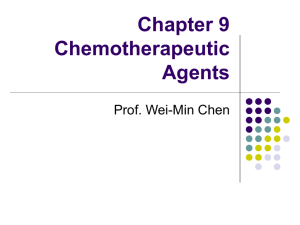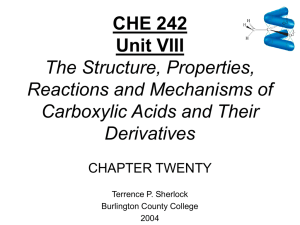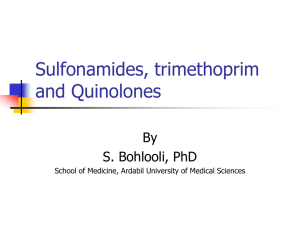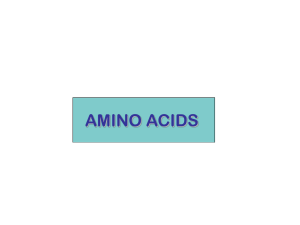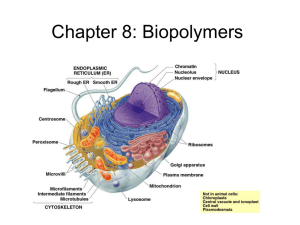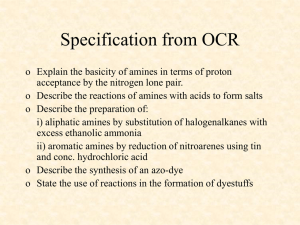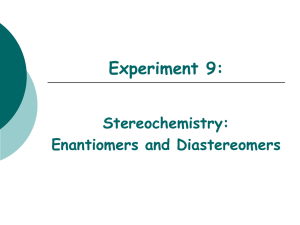MedChem-3_1
advertisement
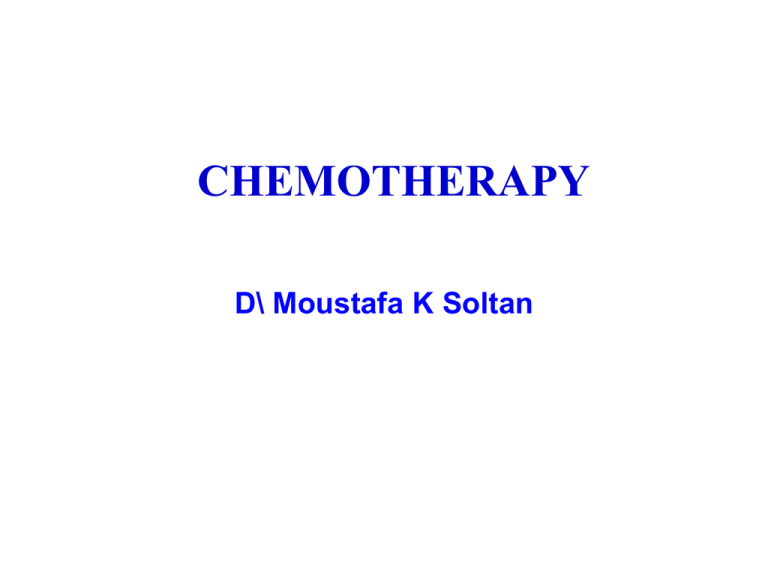
CHEMOTHERAPY D\ Moustafa K Soltan • Chemotherapy = chemical therapy = treatment with chemicals • Definition: Defined by Paul Ehrlich, long time ago, as: “the use of chemical agents to harm an invading organism or cell without harming the host”. • Chemotherapeutic agents: Chemical agents that harm an invading organism or cell without harming the host. Invading organism or cell Microbes Bacteria Fungi Cancer cells Parasites Viruses Protozoa (Unicellular) Helminths (Worms) (Multicellular) Entamoeba Leishmania Giardia Nematodes Trematodes T richomonas (Flukes) T rypanosoma (round worms) Malaria Cestodes (T ape worms) Selective toxicity ≡Affecting an invading organism or cell without affecting the host • Measured by the chemotherapeutic index. Chemotherapeutic agent M et ab ol ism x To th w ro ce g n t a en ist v s re re p r o or n l il tio a K tiv c a In Immune defence t ici y Invading organism or cell Host Infection or invasion Chemotherapeutic index = Concentration harmful to the host Concentration harmful to the microbe, parasite or cancer cell • High chemotherapeutic index = high selective toxicity. • Optimally should be above 100. In basic pharmacology: therapeutic index is deduced from doseMedian toxic dose (T 50 D) response curves. T herapeutic index = Median effective dose (ED 50) • High therapeutic index = wide safety margin. Antibacterial agents Antibacterial Agents Natu ral anti bacte ri al age n ts (An ti bi oti cs) S ynth e ti c an tibacte rial age n ts Topi cal age nts S yste m i c age n ts Disinfect ant s Ant isept ics P reservatives Sulphonamides Urinary ant isept ics Ant imycobact erial agent s Ant it ubercular agent s Ant ilepral agent s Topical synthetic antibacterial agents Disinfectant: • A chemical agent applied to inanimate objects to destroy pathogenic microorganisms. Required to be bactericidal. • Inanimate objects = surgical instruments, syringes and needles, house-hold objects. Antiseptic: • A chemical agent applied to living tissues to kill or prevent the growth of pathogenic microorganisms. May be bactericidal or baceriostatic. • Living tissues = skin and mucous membranes. Preservative: • A chemical agent added to foods or pharmaceutical formulations to prevent the growth of pathogenic microorganisms. • A chemical agent may act as disinfectant, antiseptic and preservative at the same time. The point is: how it is applied. • Example: Alcohol (ethanol): – when applied to syringe needles disinfectant. – when applied to site of injection antiseptic. – when added to pharmaceuticals preservative. Alcohols Alcohols When R = more than 8 carbon atoms When R = 1-8 carbon at oms * Increasing number of carbon at oms * Increasing number of carbon at oms increase in activit y (Inverse relat ionship) increase in activit y (direct relat ionship) Why ?? as nucleophilicity of oxygen and acidit y of alcohols increases) * Branching Why?? as wat er solubilit y decreases, large amounts are needed t o get t he MIC. act ivit y. CH3OH CH3CH2OH CH3CH2CH2OH CH3CHOH CH3 Mode of action: Denaturation of proteins inhibition of enzymes. Ethyl Alcohol (Ethanol; alcohol): Effective concentration = 60 – 95 % Uses: disinfectant, antiseptic, preservative and solvent. As a solvent [spirit (100% alcohol), tincture (alcohol & another solvent)]. Problem: alcohol abuse (chronic alcoholism) due to its pleasant odour and CNS stimulant (cortical effect causing excitation) then depressant activity. Treatment of chronic alcoholism: using the aldehyde dehydrogenase inhibitor, disulfiram. Disulfiram CH3CH2OH CH3CHO Aldehyde dehydrogenase CH3COOH Disulfiram inhibits aldehyde dehydrogenase leading to accumulation of acetaldehyde which gives unpleasant feeling. S N S S N S Denatured alcohol: Alcohol to which methanol is added for use for special purposes such as mouth washes, after-shave lotions, and preparing plant extracts. Methanol in this case is deliberately added to prevent its abuse. Benzyl alcohol: OH Assay: O OH Ac2O / pyridine O CH3 (Known excess) Benzyl acetate T it rat e wit h NaOH / ph.ph indicat or Uses: As a preservative (1-4 %) in vials of injectable drugs. Antiseptic. + excess Ac 2O H2O CH3COOH Cl CH3 Chlorbutanol: Cl OH Cl CH3 2,2,2-Trichloro-1,1-dimethyl ethanol Assay: Cl CH3 Cl OH Cl CH3 + 4 NaOH heat CH3 NaOOC OH + 3 NaCl CH3 determined by Volhard's met hod Add known excess of AgNO3 in presence of HNO3. NaCl + AgNO3 AgCl + NaNO3 Excess AgNO3 is titrated with NH4SCN using ferric alum as indicator. Uses: As a preservative in injections, ophthalmic and nasal preparations. Phenols OH OH OH OH OH CH3 OH Phenol Resorcinol CH3 o-Cresol m-Cresol CH3 p-Cresol OH OCH3 Cl OH Cl C H2 OH Cl Thymol HO Eugenol Cl Cl Hexachlorophene Cl SAR of phenols: . Hydroxy group should be free Halogen Alkyl Alkoxyl Nitro increase activity * Increasing the number of halogen atoms increases bactericidal activity (up to a limit). Polyhalogenated phenols have limited water solubility. * The best position for halogen is the para position. * Increasing length of the alkyl group increases bactericidal activity (up to a limit). Large alkyl derivatives have limited water solubility. * The best position for alkyl is the ortho position. Mode of action: ** At low conc. precipitation of proteins inhibition of enzymes. (due to its acidic properties). ** At high conc. lysis of bacterial cell membranes. (powerful cellular poisons). Phenol (Carbolic acid): SO3Na OH ONa + 2 NaOH heat Sod. benzenesulphonate Cl H + Na2SO 3 + H2O OH ONa NaOH heat / pressure H Assay: Bromometry OH OH Br + Br 3 Br2 + 3 HBr Br Add known excess of KBr / KBrO3 mixture to phenol. Add acid and allow to react for a suitable time. Excess Br2 is determined iodometrically as follows: Add KI and titrate the liberated I2 with Na2S2O3 using starch as indicator. Uses: Obsolete in the US and Europe. Here may be used as disinfectant and antipruritic. Resorcinol: 1,3-dihydroxybenzene Assay: Bromometry. Uses: Antiseptic (less potent than phenol) and keratolytic. These two properties are important in seborrhea and acne. Problem: Chemically unstable in solution (easily oxidized). This led to the development of resorcinol monoacetate. OH Resorcinol monoacetate: O O CH3 It is a prodrug for resorcinol. It slowly llberates resorcinol by the action of esterases. Advantages over resorcinol: more chemically stable in solution. Has more prolonged action. Picric acid: 2,4,6-trinitrophenol Explosive, therefore it should be stored while covered with an equal amount of water. Preparation: OH OH O2N NO2 Nitrating mixture H2SO 4 / HNO3 NO2 Assay: - Direct titration with NaOH using ph.ph as indicator (due to high acidity). Uses: Antiseptic in case of burns. Hexachlorophene: Bis(3,5,6-trichloro-2-hydroxyphenyl)methane Preparation: Cl Cl Cl 1) KOH / 1 mole 2) Acid Cl Cl OH HCHO H2SO 4 2 Cl Hexachlorophene Cl Aldehydes: Formaldehyde gas: HCHO; CH2O Formalin: aq. Solution containing not less than 37% formaldehyde and 10-15% methanol to prevent polymerization. Stability: unstable in solution. Easy oxidation formic acid. Easy polymerization paraformaldehyde. Mode of action: Direct alkylation of nucleophilic groups in proteins (NH2, SH, OH). Adverse reactions: Highly allergenic. Cancer suspect agent. Chlorine-containing compounds (Chlorophors Chlorine gas Cl 2 Sodium hypochlorite NaOCl Calcium hypochlorite Ca(OCl) 2 Cl Chloramine-T H3C SO2N Na Cl Dichloramine-T H3C SO2N Cl Halazone HOOC To disinfect water, swimming pools and utensils. Cl SO2N Cl Mode of action: In water, they release hypoclorous acid which can chlorinate amide nitrogen atoms or oxidize thiol (SH) groups of proteins. Chloramine-T: Sodium N-chloro-p-toluenesulphonamide. Dichloramine-T: N,N-dichloro- p-toluenesulphonamide. Halazone: N,N-dichloro- p-carboxybenzenesulphonamide. Synthesis of Chloramine-T and Dichloramine-T: H3C ClSO3H H3C SO2Cl NH3 H3C SO2NH2 NaOCl Dichloramine-T Excess NaOCl Chloramine-T Cationic surface active agents (Cationic surfactants): Quaternary ammonium or pyridinium salts R2 R1 X N R4 X N R R3 Mode of action: • They have surface active properties (ability to reduce interfacial tension) and therefore, they can be used as detergents, emulsifiers and germicidal as well. N Hydrocarbon tail (Lipophilic) Cationic head (Hydrophilic) • Adsorption on surface of bacteria and then lysis of bacterial cell wall and cell membrane. Advantages: • High water solubility. • Non-staining. • Non-toxic. • Non-corrosive. • Effective at low conc. Cl N CH3 R CH3 Benzalkonium chloride (R = alkyl C8-C16) CH3 H3C (CH2)15 N Br CH3 CH3 Cetyltrimethylammonium bromide Disadvantages: • Incompatible with anionic surfactants (soaps). Therefore, any traces of soap should be removed before the application of these agents. • Low activity in presence of pus or serum. Dyes • The obvious disadvantage is that they are staining. • They are mainly bacteriostatic. Gentian violet (Crystal violet): (a triphenylmethane dye) • Antibacterial (Gram +ve) and antifungal (tinea & yeast). OH N C N N C HCl NaOH N Leucobase Hexamethyl-prosaniline N Dye N Synthesis: CH3 H3C N CH3 N + CH3 H3C N,N-Dimethyl-p-toluidine H3C N NaCl Gentian violet Nit robenzene (mild oxidation) CH3 Assay: Direct titration with titanous chloride while boiling in presence of sod. pot. Tartarate. Activity: Antibacterial (Gram +ve) and antifungal. Its main use, however, is treatment of fungal infections (tinea and yeast). NH2 Aminacrine: N 9-Aminoacridine Preparation: COOH COOH CuO / K2CO3 + Cl H2 N Ullman reaction N H heat O Aminacrine POCl3 heat N H Mode of action At physiological pH, aminacrine is protonated and the acquired positive charge is delocalized between the ring nitrogen and the side chain nitrogen. Being a flat molecule, aminacrine acts through intercalation between base pairs of DNA of bacteria. The positive charge assists intercalation through electrostatic attraction to the negatively charged phosphate of DNA. The result of intercalation is failure of double-stranded DNA into single strands so that cell division is arrested. Methylene blue: (a phenothiazine dye) Cl N 3,7-Bis(dimethylamino)phenothiazinium chloride S N N Uses: • Antiseptic. • Small dose treatment of methemoglobinemia. Methylene blue is reduced by a dormant reductase to the leucobase (reducing agent). The leucobase reduces iron in methemoglobin (in the ferric state) to ferrous thus rendering it to normal hemoglobin. • Large dose treatment of cyanide poisoning. It induces a state of methemoglobinemia by converting ferrous iron in hemoglobin to the ferric state. Cyanide has higher affinity to methemoglobin compared to cytochrome. Assay: Direct titration with titanous chloride (self indicator). Mercury-containing compounds: HgOH Merbromine (Mercurochrome): Disodium 2,7-dibromo-4-hydroxyMercury fluorescin. NaO Br O O Br COONa Assay: Bromine content: The organic bromine is converted to NaBr by the double crucible method. The resulting NaBr is determined by Volhard’s method. Mercury content: Heat with NaOH / Zinc powder. Dissolve the resulting amalgam in HNO3 to give Hg(NO3)2. Titrate with NH4SCN using ferric alum as indicator. Uses: antiseptic. Synthesis: HO OH HO HO OH + O H2SO4 O O heat O OH O O Fluorescein Br2 / HOAc Compound Hg(OAc)2 HO O OH NaOH Br Br COOH Urinary antiseptics Hexamine (Methenamine): N N O N Acidic pH N H H Formaldehyde (CH2)6N4 Hexamethylenetetramine Mode of action: • The free base has no antibacterial action. • Hexamine liberates HCHO in the acidic pH of urine (4.5-5.5). Formaldehyde then exerts antiseptic effect in the urinary system. • Acidifying the urine by the concurrent administration of NH4Cl is advantageous. – Do NOT consume urinary alkalinizers such as milk and antacids • An alternative is to use methenamine mandelate which is hydrolyzed in the body to release methenamine and mandelic acid. Mandelic acid, in addition to having antibacterial effect, it helps to maintain acidic urine. N HO N N COOH . N • Bacteria which elaborate urease are resistant to hexamine because urease hydrolyze urea to ammonia which make urine alkaline. In this case, a urease inhibitor such as acetohydroxamic acid should be concurrently administered. O OH H3C N H Nitrofurans Broad-spectrum germicidal agents (Gram +ve and Gram –ve bacteria, fungi and some protozoa such as trichomonas vaginalis). O O O2N O2N NH O C H N N O Nitrofurantoin (Macrofuran) (Oral) O C H N N H NH2 Nitrofurazone (Furacin) (Topical) Nitrofurans are withdrawn in many countries due to their serious adverse reactions such as: – Hypersensitivity reactions. – Suspect mutagen and carcinogen. Fluoroquinolones – – – – Active against a variety of Gram(+ve) & (-ve) Relatively nontoxic, well-tolerated Developed because of good Gram(-ve) activity Modest Gram(+ve) activity improving! Required pharmacophore O COOH N N Nalidixic acid (NegGram) First clinically useful agent O F 6 5 4 7 N 8 N1 O COOH 3 F 2 N HN COOH N N HN Enoxacin Norfloxacin (Noroxin) Bioisostere of norfloxacin O F N HN O COOH F N N N Ciprofloxacin (Cipro) COOH N O Ofloxacin (Tarivid) Conformationally restricted SAR: The minimum pharmacophore required for antibacterial activity is: * 4-pyridone ring. * 3-carboxylic acid group. Reduction of the 2,3-double bond loss of activity. The 6-fluoro group increases lipophilicity facilitates penetration into tissues. The piperazine moiety broaden spectrum to include Pseudomonas aeroginosa. On the other hand, it increases affinity for GABA receptors resulting in CNS side effects. Required pharmacophore O F N HN COOH N R Mode of action: Inhibition of DNA supercoiling by inhibiting bacterial DNA gyrase (an enzyme equivalent to topoisomerase II in human involved in DNA synthesis). Fluoroquinolones have selectivity for gyrase because it is sufficiently different from topoisomerase II. Clinical uses: Urinary tract infections caused by Gram –ve bacteria – E. coli, Klebsiella, Pseudomonas Treatment of resistant gonorrhea (an alternative to G3 cephalosporins). Treatment of atypical pneumonias. Other indications: gastroenteritis, meningitis, bone and joint infections, biliary tract infections, and lower respiratory tract infections. Incompatibilities: Incompatible with metals due to the high chelating ability of the 4-carbonyl group with the 3-carboxylic acid group. – Antacids (Mg, Al), – Hematinics (iron), – Mineral supplements (Zn) Incompatible with dairy products (Ca). M O 2+ O F OH N HN N R Advise patients: May cause dizziness or lightheadedness DO NOT use (4h before, 2 h after taking medication) Mg or Al containing antacids Fe or Zn containing products Multi-vitamins Do not take with milk or dairy products - use a glass of water Take 1 hour before or 2 hours after food Moderate to severe photosensitivity can occur – advise patients to use a sun screen NOT recommended for children/pregnant women Sulfonamides First effective antibacterial agents that could be used systemically. Historical background: In the search for new antibacterial agents for streptococcal and staphylococcal infections (major killers at that time), azodyes were screened for possible antibacterial activity. Gerhard Domagk (a physician) in 1932, screened prontosil and found that it is active against streptococcal infections in mice (in vivo) but inactive on bacterial cultures (in vitro). In 1935, it was concluded that sulfanilamide is the active antibacterial agent and that prontosil is a prodrug (the first ever prodrug) metabolized in vivo to release the active species. H2N N NH2 N Prontosil (inactive in vitro) (active in vivo) SO2NH2 in vivo H 2N NH2 NH2 + H2N SO2NH2 Sulfanilamide • Domagk won the Nobel prize in medicine for this discovery in 1939 but the Gestapo prevented him from receiving the prize at that time. • Sulfonamides played a significant part in world’s history by saving Winston Churchill’s life during World war II. • After sulfanilamide, hundreds of sulfonamides were developed through molecular modification. • The use of penicillin in the 1940s largely replaced sulfonamides due to: – Toxicity in some patients. – Bacterial resistance due to early worldwide indiscriminant use. • Today, the use of sulfonamides is limited to treatment of • The discovery of sulfonamides triggered the modern progress of chemotherapy and the concept of prodrugs. • Many pharmacologically active compounds were developed through molecular modification of sulfanilamide. O O H2N NH2 S R SO2NH HN O Dapson e (anti le protic) HOOC O Cl H2NO2S H N COOH Fu rose m i de (diu re ti c) SO2 N Probe n e ci d (anti gout) S ul fonyl u re as (hypogl yce mi c) Cl N H2NO2S S NH O O C h loroth i az i de (diu re ti c) R` SAR Sulfanilamide is the prototype of sulfonamides H2N NH SO2NH2 O O O Anilino amino group S Sulfonamido amino group It ionizes at physiological pH as follows: NH2 H2N SO2NH2 H2N SO2NH +H The active form of sulfanilamide is the ionized form (water-soluble). However, adequate lipophilicity (lipid solubility) is required for the sulfonamide to pass through bacterial cell walls. High degree of ionization is detrimental for NH2 O Sulfanilamide has weak activity How can we explain this? • As an acidic drug: % ionized = % ionized = 100 1 + 10 (pKa-pH) 100 1 + 10 (10.4 - 7.4) = ~ 0.1 • Activity could be increased by lowering the pKa of sulfanilamide. How can we achieve this? – By replacing one of the sulfonamido hydrogens by electron-withdrawing moieties in order to increase acidity of the remaining hydrogen and hence lower the pKa. Question: • Sulfadimidine has greater activity compared to sulfanilamide… How can you explain this? N H2N SO2NH2 H2N SO2NH N Sulfadimidine pKa = 7.4 Sulfanilamide pKa = 10.4 % ionized = 100 1 + 10 (7.4 - 7.4) = 50 • Studies revealed that maximum activity is exhibited by sulfonamides of pKa values 6.6 to 7.4 (% ionization ~ 50 – 80%). • The nonionized form is insoluble at the acidic pH of urine and tend to form crystals in the renal tubules “crystalluria” causing renal damage. Question: • Sulfanilamide (pKa = 10.4) causes much more crystalluria compared to sulfamethoxazole (pKa = 6)… why? H2N SO2NH2 H2N SO2NH N Sulfanilamide pKa = 10.4 O Sulfamethoxazole pKa = 6.0 100 = ~ 0.01 (sulfanilamide) (10.4 - 6) 1 + 10 100 = 50 (sulfamethoxazole) % ionized = (6 - 6) 1 + 10 % ionized = • In conclusion, pKa of the sulfonamide determines both activity and toxicity. SAR Summary • The anilino amino group: – Important for activity. – Should be at para position. – Should be unsubstituted (except acylation to make prodrugs). • The aromatic ring: – Essential for activity. – Substitution at ortho or meta position destroys activity. • The sulfonamido group: – Essential for activity. – It should be secondary and substituted with electronwithdrawing heterocycles. Classification: • Classified according to therapeutic application into: A. Sulfonamides for systemic infections B. Sulfonamides for urinary tract infections C. Sulfonamides for intestinal infections D. Sulfonamides for ophthalmic infections E. Sulfonamides for burn therapy Sulfonamides for systemic infections • Well absorbed from GIT and effective orally. • Examples: sulfanilamide, sulfapyridine, sulfadiazine, sulfamerazine, sulfadimidine and sulfathiazole. N H2N H2N SO2NH Sulfadiazine N SO2NH N Sulfathiazole S Synthesis of sulfadiazine: O O N HN SO2Cl + H2N N HN N SO2NH N 1) NaOH 2) HOAc N H2N SO2NH Sulfadiazine N Sulfonamides for intestinal infections • Sulfonamides that are so hydrophilic that they are poorly absorbed from the GIT and exert a local action in the intestine. • Examples: sulfaguanidine, succinylsulfathiazole and phthalyl-sulfathiazole. • The latter two are designed as hydrophilic nonO absorbable prodrugs of sulfathiazole that are hydrolysed NH slowly in the large intestine to release the active N H2N SO2NH HN SO2NH sulfonamide. NH2 S COOH Sulfaguanidine Succinylsulfathiazole O N HN SO2NH S COOH Phthalylsulfathiazole Sulfonamides for ophthalmic infections • Highly soluble at physiological pH. • Example: sulfacetamide sodium. H2N Na O SO2N CH3 Sulfonamides for burn therapy • Particularly effective against species of bacteria that are usually associated with failures in burn therapy Pseudomonas aeroginosa and Clostridium welchii . • Examples: silver sulfadiazine and mafenide. Ag H2N N SO2NH S Silver sulfadiazine SO2NH2 H2N Mafenide • Silver sulfadiazine is very slightly soluble and not absorbed and releases sulfadiazine slowly. • Mafenide is not a true sulfonamide and acts by a different mechanism of action. Sulfonamides for urinary tract infections • Rapidly absorbed and slowly excreted so reach high concentration in the urinary system. • Examples: sulfacetamide and sulfamethoxazole. O H2N H2N SO2NH Sulfacetamide CH3 SO2NH N O Sulfamethoxazole Chemical name for sulfacetamide: N-(p-aminobenzenesulfonyl)acetamide * Sulfamethoxazole is usually used in combination with trimethoprim marketed under many trade names such as Sutrim, Bacterim, Septazole, Enterim, … Crystalluria • The main side effect of sulfonamides • High pKa sulfonamides and their N4-acetylated metabolites tend to exist at the acidic pH of urine exclusively as the non-ionized form which is insoluble and tend to crystallize in the renal tubules causing severe renal damage. • Measures to reduce crystalluria: – The use of sulfonamides with lower pKa values such as sulfadiazine, sulfacetamide and sulfamethoxazole. – The use of sulfonamide combinations. This allows reduction of the dose of each sulfonamide. Other side effects – High fluidare: intake. anemia in of patients deficient inNaHCO glucose-6-phosphate –Hemolytic Alkalinization urine using 3. dehydrogenase Compete with warfarin for plasma protein binding sites => toxicity Mode of action: • Sulfonamides inhibit bacterial DNA synthesis through competitive antagonism to para-aminobenzoic acid (PABA)… how? O O H2N H2N N S O R O PABA Sulfonamides • Being structurally similar, sulfonamides compete with PABA forOHdihydropteroate synthetase thereby producing O O COOH .. N non-functional (fake) DNA. H N N O P O H2N N O P OH O N H Dihydropteridine diphosphate 2 O .. H2N OH PABA Glutamic acid COOH OH O O .. N N O P O O H2N N P COOH H2N OH O N H O .. Dihydropteridine diphosphate Glutamic acid COOH H2N OH PABA Dihydropteroate synthetase Sulfonamides Sulfones PAS - OH O N N H2N Trimethoprim Pyrimethamine Methotrexate N - N H HN Dihydrofolic acid Dihydrofolate reductase Tetrahydrofolate NH2 OCH3 N H2N COOH N H Thymidylate N Trimethoprim OCH3 OCH3 DNA COOH • Sulfonamides are bacteriostatic. • Human DNA synthesis is not inhibited since human cells use ready folic acid from diet (do not have to make folic acid). • Bacterial cells cannot make use of host’s folic acid since bacterial cell walls are impermeable to folic acid. • Sulfonamides are inactive in the presence of pus or necrotic tissues since they are sources for nucleotides. • Sulfonamides/trimethoprim combination has synergistic antibacterial action due to “sequential blockade” of bacterial DNA synthesis, i.e., they act on two successive steps in DNA synthesis. Spectrum of activity: Gram-positive bacteria (especially pneumococci and meningococci), Gram-negative bacteria, Chlamydia and some protozoa. Mechanism of resistance: • Antimycobacterial Agents Mycobacteria: Mycobacterium tuberculosis => Tuberculosis Mycobacterium leprae => Leprosy (Hansen’s disease) • Slow-growing and difficult to stain (acid-fast bacilli). • Abnormally high lipid content (mycolic acid) of the cell envelope. • Treatment of mycobacterial infection complicated by: – Intracellular location of mycobacteria - phagocytes – Drug resistance – Chronic nature of these diseases • In tuberculosis, the bacilli reach the alveoli, ingested by pulmonary macrophages, fibroblasts then enclose the infection site leading to formation of granulomas or tubercles, hence the name Tubercle Bacillus (T.B). Diagram of cell wall • Leprosy primarily affects the skin as chronic granulomatous infection. • Tuberculosis primarily affects the lung (pulmonary tuberculosis) but infection may extend to brain, bones, eyes and skin (extrapulmonary tuberculosis) especially in HIV-infected patients. Tuberculosis Clinical picture of leprosy: Antitubercular agents • Based on history of discovery, sulfanilamide then dapsone then streptomycin (a turning point) then PAS then isoniazid then ethambutol then rifampin. • Due to multiple drug resistance, a combination of two or three of these agents is usually used. • Classification: A) p-Aminosalicylic acid derivatives. B) Pyridine carboxylic acid derivatives. C) Miscellaneous agents. COOH p-Aminosalicylic acid (PAS): OH Mode of action Two possible mechanisms: NH • Similar to the mode of action of sulfonamides: 2 Being structurally similar to PABA, it acts as a competitive antagonist to PABA by inhibiting COO the dihydropteroate synthetase eventually inhibits OH biosynthesis of mycobacterial DNA. • It chelates trace elements. Ca HN Disadvantages: O – Gastrointestinal irritation. – Short half life (short duration). • To overcome these disadvantages: – It should be formulated in enteric-coated dosage form or an antacid (aluminum hydroxide) is prescribed concurrently. – Developing less GI irritaing and longer acting 2 ++ Pyridinecarboxylic acid derivatives: Isoniazid (INH): O NHNH2 • Isonicotinic acid hydrazide. Synthesis: O OH N O OEt O NHNH2 OH EtOH / H2SO4 OH NH2NH2 OH N N N N Pyridoxine Mode of action: • Inhibition of the biosynthesis of mycolic acids (branched long chain fatty acids) which are important components of the cell wall of mycobacteria. • Active only against dividing mycobacteria. NOTES: 1) INH is the most active antitubercular agent rather than any other synthetic or antibiotic. 2) the equation of the assay is as follows: CONHNH2 N + 2Br2 + H2O COOH N2 + HBr + N 3)Ftivazide is hydrazone results from reaction of INH with benzaldehyde derivatives, It is as active as INH but non toxic. OCH3 CONHN C H Ftivazide N OH Side effects of INH: long-term therapy may result in fatal drug induced hepatitis. It causes peripheral neuritis as it results in pyridoxine deficiency by acting as a pyridoxine antagonist therefore, the concurrent administration of pyridoxine (vitamin B6) prevents the occurrence of peripheral neuritis. INH is metabolized by acetylation. Nearly half of the population are fast acylators of INH and the other half are slow acylators of INH. Slow acylators (including middle S NH2 easterns) are genetically deficient of N-acetyltransferase and are more prone to the side effects of INH. Ethionamide: Developed as a less toxic (5 times) analogue of INH. Mode of action like INH. Active only against dividing mycobacteria. N a H SAR: O N H b N H c N Aromatic ring: • If replaced by benzene, piperidine or thiazole loss of activity. Hydrazide moiety: • The -position is the best position for activity. • Replacement of Ha with alkyl groups decreases activity. • Replacement of Hb and/or Hc with small alkyl groups increases activity. large alkyl groups decreases activity. • Replacement of Hb and Hc with alkylidene Diazine derivatives ( pyrazinamide ). NH2 N O N Pyrazinamide N KMnO4 N / -CO2 N N quioxaline benzopyrazine Assay: COOH Pyrazinedioic acid NH2 N COOH N N Kjeldahl method COOH N CH3OH/HCl COOEt N NH3 N CONH2 N O N COONa + NaOH Boiling in AMMONIA + NH3 which is recieved in N distillation apparatus N boric acid to form ammborate which is titratrated by st HCl and methyl red indicator Miscellaneous agents Ethambutol (Etibi): Mode of action: • Being structurally similar to cellular polyamines (spermidine and spermine), it interferes with their function (essential for integrity of nucleic acids). H2N N H NH2 Spermidine • It chelates divalent metals thus inhibiting essential enzymes. O N H M O N H Synthesis of ethambutol: HO 2 NH2 + Cl Cl Base - 2HCl Antitubercular antibiotics: Streptomycin Cycloserine Rifampin Ethambutol Antileprotic agents A) Sulfones: O H2N S NH2 O Dapsone:Di-(4-aminophenyl)sulphone. • The drug of choice for the treatment of leprosy. • In addition to the antileprotic effect, dapsone has also antimalarial and antileshmanial activities. Mode of action: • Acts by a mechanism similar to sulfonamides. Evidences: • PABA partially antagonizes the action of sulfones. • Cross resistance between sulfonamides and sulfones. Disadvantage: • Poor solubility poor formulation Dapsone prodrugs (soluble dapsone analogs): Solapsone:Tetrasodium salt of Bis[4-(3phenyl-1,3-SO Na O NaO S disulphopropylamino)phenyl]sulphone HN S NH 3 3 O SO3Na NaO3S Solapsone undergoes acidic hydrolysis in the stomach to release dapsone which is the active antileprotic drug. Synthesis of Dapsone 2 Cl NO2 Na2S O2N S NO2 OXID K2Cr2O7 Dapsone RED Zn / HCl O2N O S O NO2 Synthesis of Solapsone O H2N S O NH2 condensation with 2 cinnamaldehyde H C H C O S O N CHO N 4NaHSO3 SO3Na NaO3S HN O S O NaO3S Solapsone NH SO3Na SAR of sulphones ( dapsone): 1) of the six isomers of diaminodiphenylsulphones only 4,4- is the active one. 2) additional substitution of phenyl ring cause loss of activity. 3)N-alkyl and N-acyl derivatives retain activity due to deacylation and dealkylation in vivo. 4)replacement of aminophenyl group with alkyl or aryl or heterocyclic group will cause loss in activity. 5)activity is exhibited by several mono and bis Schiffs base of aromatic aldehydes and aldehyde-bisulphite complexes as in glucosulphone, and glucosulphone has weak activity in vitro as no hydrolysis which regenerate ACTIVE DAPSONE. 6) sulphone group is essential for activity. B) Miscellaneous agents: Clofazimine:N,10-bis-(4-chlorophenyl)-2,10-dihydro-2[1-methylethylamino]-3-phenazinamine Cl • A phenazine dye • Binds preferntially to mycobacterial DNA • Teratogenic N N N N H Cl Thiambutosine: • A thiourea derivative • N-(4-butoxyphenyl)-N- -(4BuO dimethylaminophenyl)thiourea Other agents used for leprosy: • Isoniazid, ethionamide, rifampin N S N H N H The American Medical Association “AMA” states: • Treatment of leprosy is difficult and complex. • A combination of dapsone / clofazimine / rifampin should be used. • Therapy duration = 5 years – life time.
